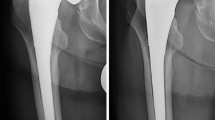Abstract
Background
Corrosion of stem-cobalt/chromium (Co/Cr) head interface and subsequent systemic Co ion complication have been a clinical concern after total hip arthroplasty (THA). The aim of this study is to investigate correlation between type of femoral head and blood Co ion level.
Methods
One hundred four patients with THA using accolade TMZF and Co/Cr femoral head (32-mm; 55 cases, 36-mm; 20 cases, dual mobility system (DM) with 22.2 or 28-mm inner head; 29 cases) participated in this study, and blood Co ion concentration test was performed in patients a minimum of four years after THA.
Results
DM group was significantly older than 32-mm and 36-mm group (DM: 73.9 ± 4.6, 32-mm: 63.3 ± 8.5, 36-mm: 66.8 ± 10.5). The median (interquartile range) blood Co concentration of each group was 32-mm group 0.26 µg/L (0.69), 36-mm group; 0.21 µg/L (0.30); and DM group 0.21 µg/L (0.13). There was a significant difference of Co concentration between DM and 32-mm group (p = 0.023). Abnormal values of the blood Co concentration (> 1 µg/L) were observed in the 32-mm group; 12 cases (21.8%), 36-mm group; 2 cases (10.0%); and DM group; 0 case (0%) (p = 0.018).
Conclusions
Co blood concentration differed among the different sizes of Co/Cr femoral head. THA using DM is a safe option with low risk of complication from cobalt ion if it is used for elderly patients.



Similar content being viewed by others
Data availability
Data available within the article.
References
Ferguson RJ, Palmer AJ, Taylor A, Porter ML, Malchau H, Glyn-Jones S (2018) Hip replacement. Lancet 392:1662–1671. https://doi.org/10.1016/s0140-6736(18)31777-x
Ochi H, Baba T, Homma Y, Matsumoto M, Watari T, Ozaki Y, Kobayashi H, Kaneko K (2017) Total hip arthroplasty via the direct anterior approach with a dual mobility cup for displaced femoral neck fracture in patients with a high risk of dislocation. Sicot j 3:56. https://doi.org/10.1051/sicotj/2017048
OECD (2021) Health at a Glance 2021: OECD indicators. OECD Publishing, Paris. https://doi.org/10.1787/ae3016b9-en
Pituckanotai K, Arirachakaran A, Tuchinda H, Putananon C, Nualsalee N, Setrkraising K, Kongtharvonskul J (2018) Risk of revision and dislocation in single, dual mobility and large femoral head total hip arthroplasty: systematic review and network meta-analysis. Eur J Orthop Surg Traumatol 28:445–455. https://doi.org/10.1007/s00590-017-2073-y
Kurtz SM, Lau E, Ong K, Zhao K, Kelly M, Bozic KJ (2009) Future young patient demand for primary and revision joint replacement: national projections from 2010 to 2030. Clin Orthop Relat Res 467:2606–2612. https://doi.org/10.1007/s11999-009-0834-6
Lanting B, Naudie DD, McCalden RW (2016) Clinical impact of trunnion wear after total hip arthroplasty. JBJS Rev 4(8):e3. .https://doi.org/10.2106/jbjs.Rvw.15.00096
Homma Y, Morikawa T, Ishii S, Baba T, Kaneko K (2020) Bowing-head sign: rare but detectable in pre-catastrophic hip implant failure. Arch Orthop Trauma Surg 140:2085–2089. https://doi.org/10.1007/s00402-020-03609-x
Bansal T, Aggarwal S, Dhillon MS, Patel S (2020) Gross trunnion failure in metal on polyethylene total hip arthroplasty-a systematic review of literature. Int Orthop 44:609–621. https://doi.org/10.1007/s00264-019-04474-z
Craig P, Bancroft G, Burton A, Collier S, Shaylor P, Sinha A (2014) Raised levels of metal ions in the blood in patients who have undergone uncemented metal-on-polyethylene Trident-Accolade total hip replacement. Bone Joint J 96-b:43–47. https://doi.org/10.1302/0301-620x.96b1.30923
Urish KL, Hamlin BR, Plakseychuk AY, Levison TJ, Higgs GB, Kurtz SM, DiGioia AM (2017) Trunnion failure of the recalled low friction ion treatment cobalt chromium alloy femoral head. J Arthroplasty 32:2857–2863. https://doi.org/10.1016/j.arth.2017.03.075
Mayo Clinic, Rochester MN (2021) Mayo medical laboratories, interpretive handbook: Interpretive data for diagnostic laboratory tests
DeLee JG, Charnley J (1976) Radiological demarcation of cemented sockets in total hip replacement. Clin Orthop Relat Res 121:20–32
Gruen TA, McNeice GM, Amstutz HC (1979) “Modes of Failure” of cemented stem-type femoral components: a radiographic analysis of loosening. Clin Orthop Relat Res 141:17–27
Brooker AF, Bowerman JW, Robinson RA, Riley LH Jr (1973) Ectopic ossification following total hip replacement. Incidence and a method of classification. J Bone Joint Surg Am 55:1629–1632
Dover C, Kuiper JH, Craig P, Shaylor P (2020) Ten years on: increased metal ion levels in a cohort of patients who underwent uncemented metal-on-polyethylene total hip arthroplasty. Bone Joint J 102-b:832–837. https://doi.org/10.1302/0301-620x.102b7.Bjj-2019-1372.R1
Yang X, Hutchinson CR (2016) Corrosion-wear of β-Ti alloy TMZF (Ti-12Mo-6Zr-2Fe) in simulated body fluid. Acta Biomater 42:429–439. https://doi.org/10.1016/j.actbio.2016.07.008
Martin JR, Camp CL, Wyles CC, Taunton MJ, Trousdale RT, Lewallen DG (2016) Increased femoral head offset is associated with elevated metal ions in asymptomatic patients with metal-on-polyethylene total hip arthroplasty. J Arthroplasty 31:2814–2818. https://doi.org/10.1016/j.arth.2016.05.047
Matsen Ko L, Chen AF, Deirmengian GK, Hozack WJ, Sharkey PF (2016) Catastrophic femoral head-stem trunnion dissociation secondary to corrosion. J Bone Joint Surg Am 98:1400–1404. https://doi.org/10.2106/jbjs.15.00914
Gessner BD, Steck T, Woelber E, Tower SS (2019) A systematic review of systemic cobaltism after wear or corrosion of chrome-cobalt hip implants. J Patient Saf 15:97–104. https://doi.org/10.1097/pts.0000000000000220
Fung ES, Monnot A, Kovochich M, Unice KM, Tvermoes BE, Galbraith D, Finley BL, Paustenbach DJ (2018) Characteristics of cobalt-related cardiomyopathy in metal hip implant patients: an evaluation of 15 published reports. Cardiovasc Toxicol 18:206–220. https://doi.org/10.1007/s12012-017-9433-z
Sanz Pérez MI, Rico Villoras AM, Moreno Velasco A, Bartolomé García S, Campo Loarte J (2019) Heart transplant secondary to cobalt toxicity after hip arthroplasty revision. Hip Int 29:Np1-np5. https://doi.org/10.1177/1120700019834793
Choi HI, Hong JA, Kim MS, Lee SE, Jung SH, Yoon PW, Song JS, Kim JJ (2019) Severe cardiomyopathy due to arthroprosthetic cobaltism: report of two cases with different outcomes. Cardiovasc Toxicol 19:82–89. https://doi.org/10.1007/s12012-018-9480-0
(IARC) IAfRoC (2006) Working group on the evaluation of carcinogenic risk to humans. Cobalt in hard metals and cobalt sulfate, gallium arsenide, indium phosphide and vanadium pentoxide
Order for Enforcement of Industrial Safety and Health Act. Amendment of Cabinet Order No. 13 of 2012. Available from: http://www.japaneselawtranslation.go.jp/law/detail/?id=2245&vm=&re=02&new=1. Accessed 7 May 2021
Hanawa T, Hiromoto S, Asami K (2001) Characterization of the surface oxide film of a Co–Cr–Mo alloy after being located in quasi-biological environments using XPS. Appl Surf Sci 183:68–75. https://doi.org/10.1016/S0169-4332(01)00551-7
Milošev I, Strehblow HH (2003) The composition of the surface passive film formed on CoCrMo alloy in simulated physiological solution. Electrochim Acta 48:2767–2774. https://doi.org/10.1016/S0013-4686(03)00396-7
Hanawa T, Nakazawa K, Kano K, Hiromoto S, Suzuki Y, Chiba A (2005) Friction-wear properties of nitrogen-ion-implanted nickel-free co–cr–mo alloy. Mater Trans 46:1593–1596. https://doi.org/10.2320/matertrans.46.1593
Agne MT, Underwood RJ, Kocagoz SB, MacDonald DW, Day JS, Parvizi J, Kraay MJ, Mont MA, Klein GR, Cates HE, Kurtz SM (2015) Is there material loss at the backside taper in modular CoCr acetabular liners? Clin Orthop Relat Res 473:275–285. https://doi.org/10.1007/s11999-014-3982-2
Gkiatas I, Sharma AK, Greenberg A, Duncan ST, Chalmers BP, Sculco PK (2020) Serum metal ion levels in modular dual mobility acetabular components: a systematic review. J Orthop 21:432–437. https://doi.org/10.1016/j.jor.2020.08.019
Philippot R, Adam P, Farizon F, Fessy MH, Bousquet G (2006) Survival of cementless dual mobility sockets: ten-year follow-up. Rev Chir Orthop Reparatrice Appar Mot 92:326–331. https://doi.org/10.1016/s0035-1040(06)75762-2
Wilbur S, Abadin H, Fay M, Yu D, Tencza B, Ingerman L, Klotzbach J, James S (2012) Toxicological profile for chromium. Agency for Toxic Substances and Disease Registry (US), Atlanta (GA)
Acknowledgements
We thank Prof. Hanawa Takao for his outstanding advice about metallic biomaterials.
Funding
This study was partly supported by JSPS KAKENHI Grant Number 19H01081.
Author information
Authors and Affiliations
Contributions
YH conceived and designed this research. YH, TB, and IS obtained the data. MT, YH, and SI analyzed data. SI wrote the initial manuscript. YH revised the manuscript. YH, SI, KK, TB, and IM interpretated the data. All authors read and approved the manuscript.
Corresponding author
Ethics declarations
Ethics approval
This study was approved by the Inst. Ethical Review Board.
Consent to participate
All authors have participated in the research.
Consent for publication
All authors of this paper have read and approved the final version submitted.
Conflict interests
The authors declare no competing interests.
Additional information
Publisher's note
Springer Nature remains neutral with regard to jurisdictional claims in published maps and institutional affiliations.
Rights and permissions
Springer Nature or its licensor holds exclusive rights to this article under a publishing agreement with the author(s) or other rightsholder(s); author self-archiving of the accepted manuscript version of this article is solely governed by the terms of such publishing agreement and applicable law.
About this article
Cite this article
Ishii, S., Homma, Y., Matsukawa, T. et al. Blood cobalt ion level in patients with different sizes of cobalt/chrome femoral head with the Accolade TMZF stem. International Orthopaedics (SICOT) 46, 2205–2212 (2022). https://doi.org/10.1007/s00264-022-05502-1
Received:
Accepted:
Published:
Issue Date:
DOI: https://doi.org/10.1007/s00264-022-05502-1




